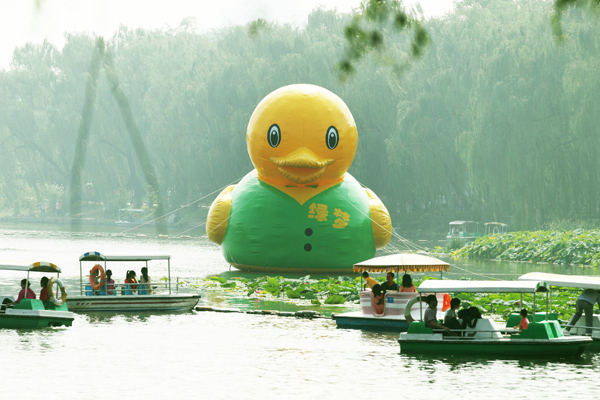 |
| A copy of Florentijn Hofman's Rubber Duck on the lake in Beijing's Yuyuantan Park.Lei Kesi /for China Daily |
Official figures show that in 1980, when China was in the infancy of reform and opening-up, the urbanization rate was a mere 19 percent. It surpassed 52.6 percent last year, which marked a historic change in the urban and rural structure, with city dwellers outnumbering their rural counterparts for the first time.
"The urbanization rates of developed countries are generally above 80 percent. This means that China has great potential in urban expansion," Zhu Di, deputy director of the arts department under the Ministry of Culture, said at a public art forum in Fujian province in June.
During the urbanization process, a dynamic city culture is taking shape at a rapid speed, he said.
"The rapid pace of urbanization in China has created extensive space for the evolution of public art. In return, public art has arisen to promote cities' cultural diversity. It breathes the air of transformation into traditional cultures, and adds new elements to the urban art landscape."
Meanwhile, public art has been entrusted with major social responsibilities. For instance, it helps build a city's image, and it reflects a city's soft power. And playing such an important role, it has inevitably aroused skepticism when it fails to satisfy city dwellers.
"It used to be a core function of public art to educate and worship heroes, which therefore produced a great deal of monuments and memorial sculptures," said Yin Shuangxi, a professor at the Central Academy of Fine Arts.


 Storms leave 97 dead, 58 missing in Mexico
Storms leave 97 dead, 58 missing in Mexico New model of indigenous surface-to-air missiles testfired
New model of indigenous surface-to-air missiles testfired  118.28-carat diamond to be auctioned in HK
118.28-carat diamond to be auctioned in HK Maternal love under streetlight
Maternal love under streetlight Naked foreign student sits in the middle of a road in Haikou
Naked foreign student sits in the middle of a road in Haikou  Colorful Yunnan: Enjoy the natural beauty
Colorful Yunnan: Enjoy the natural beauty Harbin named Chinese city with most beautiful women
Harbin named Chinese city with most beautiful women New college students' military training in Guangzhou
New college students' military training in Guangzhou Rugby girls
Rugby girls PLA's 38th Group Army conduct training
PLA's 38th Group Army conduct training Residences of the royal house of Savoy
Residences of the royal house of Savoy The last days of Wan Aihua
The last days of Wan Aihua Highlights at 12th National Games of China
Highlights at 12th National Games of China Beijing Film Academy welcomes freshmen
Beijing Film Academy welcomes freshmen 2013 Taiwan Int'l Tourism Expo kicks off in Taipei
2013 Taiwan Int'l Tourism Expo kicks off in TaipeiDay|Week|Month